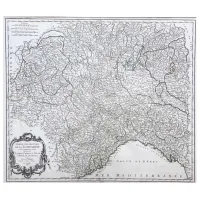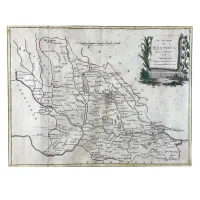Ancient map of Padua by Giovanni Valle Giustinopolitano from the 18th century
Luxury antiques
SKU: ANT-A1012
See other products from category Antique prints or from manufacturer Antyki with shipping within 24 hours
Description
Zatta Antonio Paduan by Giovanni Valle Giustinopolitano, Venice 1784 An enchanting and detailed geographical map of the territory of Padua taken from the monumental work Atlante Novissimo, illustrated and supplemented with observations and discoveries made by the most famous and contemporary geographers, by Antonio Zatta, published in four volumes, with maps of the entire world, between 1775–1785 at the Remondini printing house in Venice. In the upper left corner, in an elegant cartouche of rustic character, which departs from the Renaissance reminiscences of previous cartographers, is the title "Il Padovano di Giovanni Valle Giustinopolitano di Nuova Projezione", followed by the publisher's signature Antonio Zatta and the date 1784. Beyond the graduated margin, the directions of the world are indicated, and in the lower left corner is the engraver's signature G. Zuliani inc. and on the right, the designer G. Pitteri wrote. The title emphasizes that the cartographic source Zatta used in creating the map is the model of Giovanni Valle.
The beautiful map is oriented so that north is at the top and in a rather innovative way presents only the area of Padua, with the bordering provinces marked in large letters (Trentino at the top, Vicenza on the left, and Polesine di Rovigo at the bottom), but without providing their characteristics or geographical representation; This allowed, combined with the coloring of the contours of the internal divisions, to focus attention on the actual subject of the map.
Unique antique furniture and accessories can be an excellent idea for decorating our interiors. Today, there are more and more enthusiasts of high-quality old products that have a specific character and soul. It is a nod to history, creation, and design of {traditional|classic} and timeless furniture. There are many different styles in antique furniture, each with its distinctive features.
There are many different styles characterizing antique furniture, but we can distinguish a few of the most important ones. Eclectic furniture belongs to the 19th century, which is marked by the reigning Biedermeier style. Its variations in the early years of this century include Neo-Gothic, Gothic, Rococo, Louis Philippe style, and finally, the English Victorian style. By the end of the century, these styles transition into pseudo styles of Classicism, Renaissance, and Baroque.
Beautiful Empire-style furniture spans the period between the end of the 18th and the beginning of the 19th century. It all originated from the reign of Napoleon. There, a significant resemblance and references to Roman and Greek decorations were imposed.
Classicist furniture is the Louis XVI style, which also strongly references ancient architecture. Interesting and noteworthy are all antique products in the Rococo and Louis XV styles. Next is Baroque, whose name comes from the Portuguese barocco – which translates to an irregularly developed pearl. These were very representative pieces of furniture, meant to literally ooze glamour and play a significant role in luxury. Exceptional, selectively used materials were employed to further emphasize the lofty tone of these products.
Today, we can observe how much influence the Baroque style had on today's classic furniture, which is designed with great similarity to the past era. Another significant style is the Renaissance, which flourished in the 15th and 16th centuries and also left a significant mark on the art of furniture making. The Renaissance style was quite heavy and massive. Brown stains were used, as well as cornices, strong plinths, and bas-reliefs. It can certainly be said that these were quite specific products, but they offered many new possibilities, such as the construction of sideboards or generally broadly understood chest furniture. Here, too, there was an interest in mythology and ancient times, so supports or legs took on animal forms.
Lion's paws, eagle's heads – this is a common sight in the Renaissance style. Currently, many global brands recreate such crafted furniture, taking examples from Italian or French creators. It is a manifestation of admiration and care for the history of the most beautiful Renaissance antiques. It is important to remember that in each country, furniture making was perceived differently, so each style in a given country had its separate character. This is very important, especially when searching for the right luxury antique for your interior.
The most important aspect of stylish antique furniture is originality. This is ultimately crucial from the buyer's perspective, as there are many counterfeits on the market. The brand Luxury Products provides a document confirming the product's compliance with the actual description and photo. At your disposal, we have art appraisers, historians, and experts from around the world.
Attributes / Details
| SKU | ANT-A1012 |
| Manufacturer | Antyki |
| Model | A1012 |
| Size | Height: 56 (40.2) cm Width: 47 (31.2) cm |
| Wiek | XVIII |
| Rok | 1700 |
| Destiny | Do salonu i gabinetu |
See catalog
Reviews
No reviews for this product.













